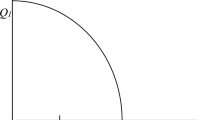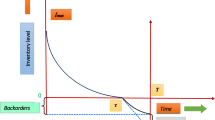Abstract
The classic economic order quantity model assumes that purchasing cost should be paid immediately after the delivery time. In practice, sometimes the vendors ask the buyers to prepay the entire or a percentage of the purchasing cost before delivery time. In this paper the buyer’s inventory control system for a decaying item under full prepayment scheme based on various conditions consisting of (1) no shortage, (2) full backordering shortage is allowed and (3) partial lost sale is permitted, are developed. Numerical analysis is provided to show the performance of the model and some managerial insights are presented based on the proposed solution technique and sensitivity analysis.




Similar content being viewed by others
References
Chang, C.-T. (2004). An EOQ model with deteriorating items under inflation when supplier credits linked to order quantity. International Journal of Production Economics, 88(3), 307–316.
Covert, R. B., & Philip, G. S. (1973). An EOQ model with Weibull distribution deterioration. IIE Transactions, 5, 323–326.
Das, D., Roy, A., & Kar, S. (2015). A multi-warehouse partial backlogging inventory model for deteriorating items under inflation when a delay in payment is permissible. Annals of Operations Research, 226(1), 133–162.
Ghare, P. M., & Schrader, G. E. (1963). A model for exponential decaying inventory. Journal of Industrial Engineering, 14(238), 243.
Ghosh, S. K., Khanra, S., & Chaudhuri, K. S. (2011). Optimal price and lot size determination for a perishable product under conditions of finite production, partial backordering and lost sale. Appllied Mathematics and Computations, 217, 6047–6053.
Gupta, R., Bhunia, A., & Goyal, S. (2009). An application of genetic algorithm in solving an inventory model with advance payment and interval valued inventory costs. Mathematical and Computer Modelling, 49(5), 893–905.
Harris, F. W. (1990). How many parts to make at once. Operations Research, 38(6), 947–950.
Jaggi, C. K., & Aggarwal, C. K. (1994). Credit financing in economic ordering policies of deteriorating items. International Journal of Production Economics, 34, 151–155.
Liao, J.-J., Huang, K.-N., & Chung, K.-J. (2012). Lot-sizing decisions for deteriorating items with two warehouses under an order-size-dependent trade credit. International Journal of Production Economics, 137, 102–115.
Lo, S. T., Wee, H. M., & Huang, W. C. (2007). An integrated production-inventory model with imperfect production processes and Weibull distribution deterioration under inflation. International Journal of Production Economics, 106, 248–260.
Maiti, A., Maiti, M., & Maiti, M. (2009). Inventory model with stochastic lead-time and price dependent demand incorporating advance payment. Applied Mathematical Modelling, 33(5), 2433–2443.
Ouyang, L. Y., Ho, C. H., Su, C. H., & Yang, C. T. (2015). An integrated inventory model with capacity constraint and order-size dependent trade credit. Computers & Industrial Engineering, 84, 133–143.
Pentico, D. W., & Drake, M. J. (2011). A survey of deterministic models for the EOQ and EPQ with partial backordering. European Journal of Operational Research, 214, 179–198.
San-José, L. A., Sicilia, J., & García-Laguna, J. (2015). Analysis of an EOQ inventory model with partial backordering and non-linear unit holding cost. Omega, 54, 147–157.
Sarkar, B., Saren, S., & Cárdenas-Barrón, L. E. (2015). An inventory model with trade-credit policy and variable deterioration for fixed lifetime products. Annals of Operations Research, 229(1), 677–702.
Sarker, B. R., Jamal, A. M. M., & Wang, S. (2000). Supply chain models for perishable products under inflation and permissible delay in payment. Computers and Operation Research, 27, 59–75.
Taleizadeh, A. A. (2014a). An economic order quantity model for deteriorating item in a purchasing system with multiple prepayments. Applied Mathematical Modelling, 38(23), 5357–5366.
Taleizadeh, A. A. (2014b). An EOQ model with partial backordering and advance payments for an evaporating item. International Journal of Production Economics, 155, 185–193.
Taleizadeh, A. A., Barzinpour, F., & Wee, H. M. (2011). Meta-heuristic algorithms to solve the fuzzy single period problem. Mathematical and Computer Modeling, 54(5–6), 1273–1285.
Taleizadeh, A. A., Mohammadi, B., Cárdenas-Barrón, L. E., & Samimi, H. (2013a). An EOQ model for perishable product with special sale and shortage. International Journal of Production Economics, 145, 318–338.
Taleizadeh, A. A., Niaki, S. T., & Aryanezhad, M. B. (2009). Multi-product multi-constraint inventory control systems with stochastic replenishment and discount under fuzzy purchasing price and holding costs. American Journal of Applied Science, 8(7), 1228–1234.
Taleizadeh, A. A., Niaki, S. T. A., & Aryanezhad, M. B. (2013b). Replenish-up-to multi chance-constraint inventory control system with stochastic period lengths and total discount under fuzzy purchasing price and holding costs. International Journal of System Sciences, 41(10), 1187–1200.
Taleizadeh, A. A., Niaki, S. T. A., Aryanezhad, M. B., & Fallah-Tafti, A. (2010). A genetic algorithm to optimize multi-product multi-constraint inventory control systems with stochastic replenishments and discount. International Journal of Advanced Manufacturing Technology, 51(1–4), 311–323.
Taleizadeh, A. A., Niaki, S. T. A., & Nikousokhan, R. (2011). Constraint multiproduct joint-replenishment inventory control problem using uncertain programming. Applied Soft Computing, 11(8), 5143–5154.
Taleizadeh, A. A., & Pentico, D. W. (2013). An economic order quantity model with partial backordering and known price increase. European Journal of Operational Research, 28, 516–525.
Taleizadeh, A. A., Pentico, D. W., Aryanezhad, M. B., & Ghoreyshi, M. (2012). An economic order quantity model with partial backordering and a special sale price. European Journal of Operational Research, 221, 571–583.
Taleizadeh, A. A., Pentico, D. W., Aryanezhad, M. B., & Jabalameli, M. S. (2013c). An economic order quantity model with multiple partial prepayments and partial backordering. Mathematical and Computer Modelling, 57(3), 311–323.
Taleizadeh, A. A., Stojkovska, I., & Pentico, D. W. (2015). An economic order quantity model with partial backordering and incremental discount. Computers & Industrial Engineering, 82, 21–32.
Taleizadeh, A. A., Wee, H. M., & Jolai, F. (2013d). Revisiting a fuzzy rough economic order quantity model for deteriorating items considering quantity discount and prepayment. Mathematical and Computer Modelling, 57(5), 1466–1479.
Thangam, A. (2012). Optimal price discounting and lot-sizing policies for perishable items in a supply chain under advance payment scheme and two-echelon trade credits. International Journal of Production Economics, 139(2), 459–472.
Wang, W. T., Wee, H. M., Cheng, Y. L., Wen, C. L., & Cárdenas-Barrón, L. E. (2015). EOQ model for imperfect quality items with partial backorders and screening constraint. European Journal of Industrial Engineering, 9(6), 744–773.
Wee, H. M. (1995). A deterministic lot-size inventory model for deteriorating items with shortages and a declining market. Computers and Operation Research, 22, 345–356.
Wee, H. M., Huang, Y. D., Wang, W. T., & Cheng, Y. L. (2014). An EPQ model with partial backorders considering two backordering costs. Applied Mathematics and Computation, 232, 898–907.
Wee, H. M., & Yu, J. (1997). A deteriorating inventory model with a temporary price discount. International Journal of Production Economics, 53, 81–90.
Wu, J., Al-khateeb, F. B., Teng, J. T., & Cárdenas-Barrón, L. E. (2015). Inventory models for deteriorating items with maximum lifetime under downstream partial trade credits to credit-risk customers by discounted cash-flow analysis. International Journal of Production Economics, Available online 30 October 2015, ISSN 0925-5273, doi:10.1016/j.ijpe.2015.10.020.
Yu, J. C. P. (2013). A collaborative strategy for deteriorating inventory system with imperfect items and supplier credits. International Journal of Production Economics, 143, 403–409.
Yu, J. C. R., Wee, H. M., & Chen, J. M. (2005). Optimal ordering policy for a deteriorating item with imperfect quality and partial backordering. Journal of the Chinese Institute of Industrial Engineers, 22, 509–520.
Zhang, Q., Tsao, Y.-C., et al. (2014). Economic order quantity under advance payment. Applied Mathematical Modelling, 38(24), 5910–5921.
Author information
Authors and Affiliations
Corresponding author
Rights and permissions
About this article
Cite this article
Tavakoli, S., Taleizadeh, A.A. An EOQ model for decaying item with full advanced payment and conditional discount. Ann Oper Res 259, 415–436 (2017). https://doi.org/10.1007/s10479-017-2510-7
Published:
Issue Date:
DOI: https://doi.org/10.1007/s10479-017-2510-7




